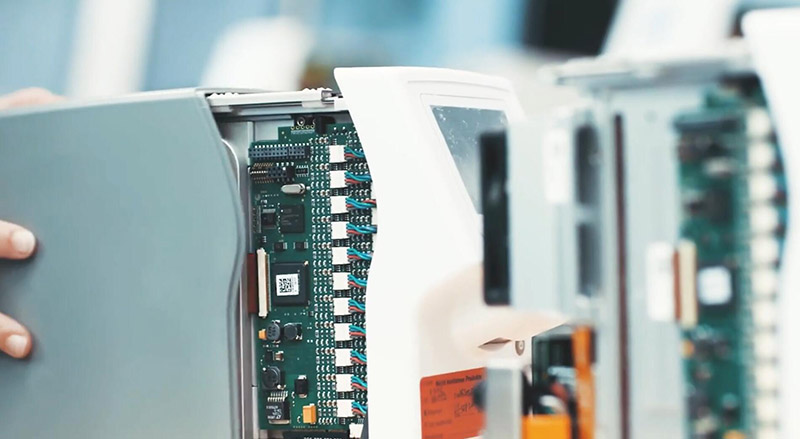Molecular diagnostic instrument PCBA assembly
Molecular diagnostics is a device used to analyze and detect biomolecules, which can be used for disease diagnosis, genetic detection, drug screening and other applications by analyzing DNA, RNA, protein and other molecules in samples. Molecular diagnostic instrument is usually composed of hardware equipment and software system, hardware equipment including circuit board, detector, light source, temperature control system and so on.

The relevant parameters of molecular diagnostic instrument mainly include the following aspects:
Sensitivity: The sensitivity of a molecular diagnostic instrument refers to the lowest concentration of the target molecule that it can detect. Higher sensitivity means the device can detect lower concentrations of target molecules, improving diagnostic accuracy.
Detection range: The detection range of a molecular diagnostic instrument refers to the type and amount of target molecules that it can detect. Different molecular diagnostics can detect different kinds of molecules, such as DNA, RNA, proteins, etc.
Detection speed: The detection speed of a molecular diagnostic instrument refers to the time it takes to complete a detection. Rapid detection can improve diagnostic efficiency and treatment effectiveness, especially in emergency and emergency situations is very important.
Accuracy and specificity: The accuracy of a molecular diagnostic instrument refers to the comparison of its detection results with standard methods. Specificity means that it can distinguish between different molecules and exclude interfering factors. High accuracy and specificity can improve the accuracy and reliability of diagnosis.
Automation and portability: The automation of the molecular diagnostic instrument means that it can automatically complete the detection process and reduce the operator’s error. Portability means that it can be easily used in different environments, such as clinical field, field, etc.

The circuit board of molecular diagnostic instrument is a core component of molecular diagnostic instrument, which is mainly used to control and process the signal of the sample, and to communicate with other devices. It has the following characteristics:
Highly integrated: The circuit board of the molecular diagnostic instrument usually needs to integrate a variety of functional modules, such as signal amplification, filtering, digital signal processing, etc., so it needs to achieve a high degree of integration in a limited space to meet the functional requirements of the instrument.
High precision and stability: The molecular diagnostic circuit board needs to have high precision and stability to ensure the accurate acquisition and processing of the sample signal. This requires the use of high-quality components in the design and manufacturing of the circuit board, as well as rigorous testing and calibration.
Low power and small size: Molecular diagnostics usually need to be portable and highly integrated, so the circuit board needs to have low power and small size characteristics to meet the portability and integration requirements of the instrument.

In the production of molecular diagnostic circuit boards, the following aspects need to be noted:
Design rationality: The design of the circuit board needs to be reasonable, including circuit layout, signal transmission path, power distribution, etc. Reasonable design can improve the performance and stability of the circuit board, and reduce signal interference and noise.
Component selection: Selecting high-quality components is critical to the performance of the circuit board. It is necessary to select components that meet the requirements, such as high-precision amplifiers, filters, ADC/DAC, etc., and pay attention to the stability and reliability of components.
Manufacturing process: When manufacturing molecular diagnostic circuit board, it is necessary to use appropriate manufacturing process, including the production of printed circuit board (PCB), welding and assembly of components. The manufacturing process needs to pay attention to details, such as welding quality, solder joint reliability, anti-static measures of the circuit board, etc.

When testing a molecular diagnostic board, the following tests need to be performed:
Circuit function test: test whether the various functional modules of the circuit board work normally, including signal amplification, filtering, digital signal processing, etc. It is possible to input different signals and observe whether the output results meet the expectations.
Signal quality test: test the acquisition and processing quality of the input signal on the circuit board. You can observe the distortion of the output signal, such as noise and distortion, by input signals of different frequencies and amplitudes.
Stability test: Test the stability and reliability of the circuit board during long-term operation. You can run the test for a long time to observe whether the circuit board has temperature drift, signal drift and other problems.
Calibration test: Test the accuracy and precision of the circuit board. It can be compared with the standard signal to observe whether the output of the circuit board is consistent with the standard signal.
The circuit board of molecular diagnostic instrument is the core component of molecular diagnostic instrument, which has the characteristics of high integration, high precision and stability, low power consumption and small size. In the production, it is necessary to pay attention to the design rationality, component selection and manufacturing process, and it is necessary to carry out circuit function testing, signal quality testing, stability testing and calibration testing.



